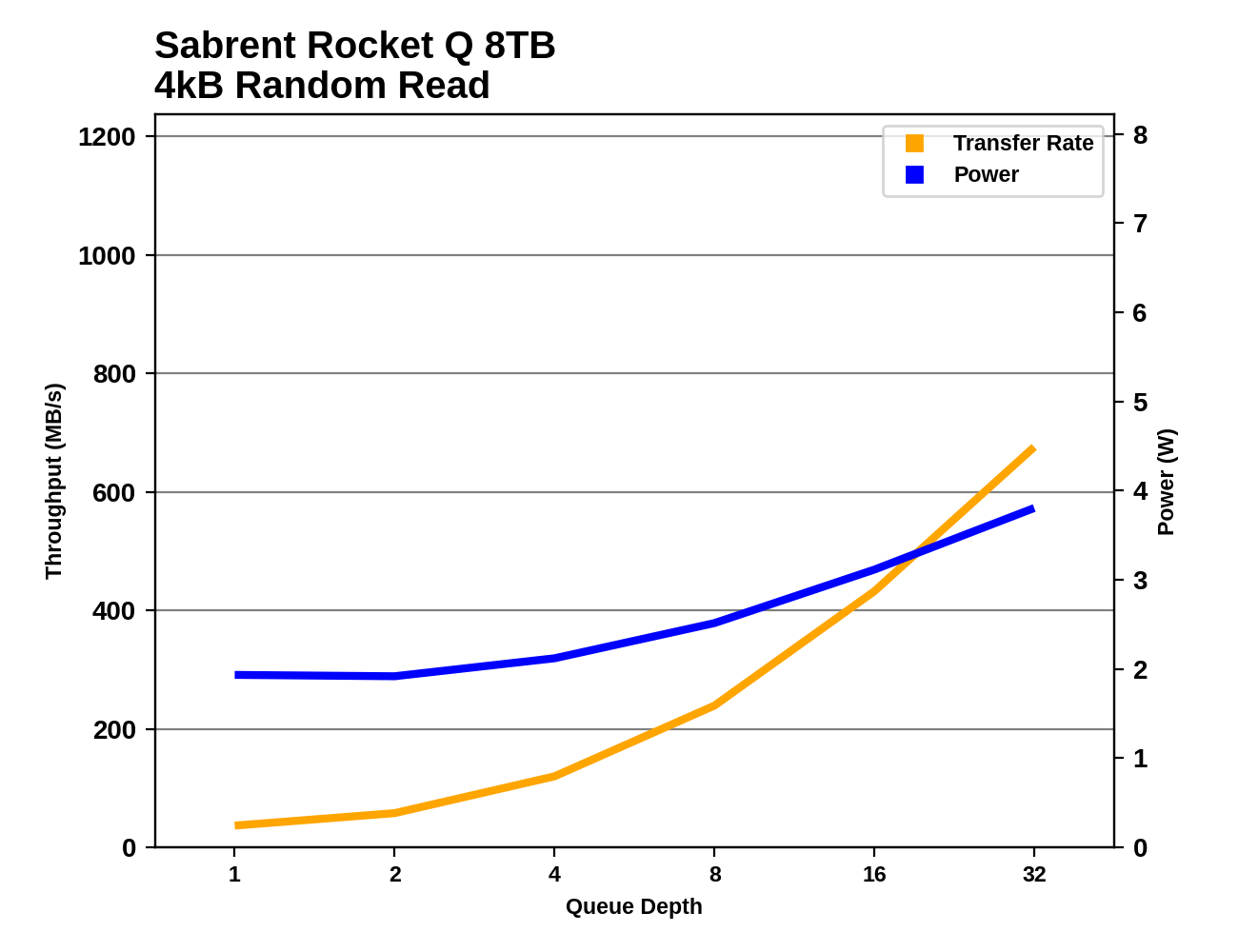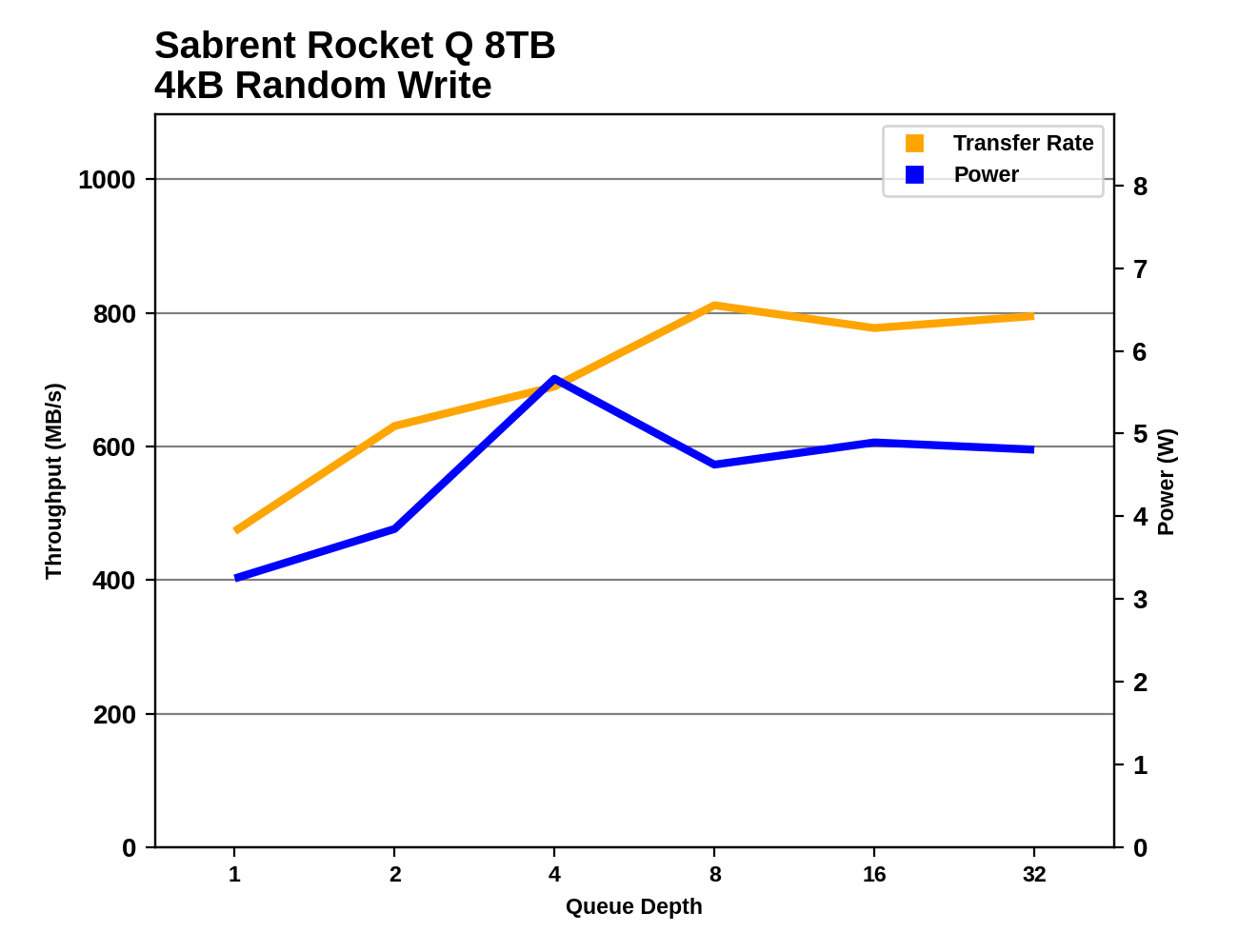QLC Goes To 8TB: Samsung 870 QVO and Sabrent Rocket Q 8TB SSDs Reviewed
by Billy Tallis on December 4, 2020 8:00 AM ESTRandom Read Performance
Our first test of random read performance uses very short bursts of operations issued one at a time with no queuing. The drives are given enough idle time between bursts to yield an overall duty cycle of 20%, so thermal throttling is impossible. Each burst consists of a total of 32MB of 4kB random reads, from a 16GB span of the disk. The total data read is 1GB.

The burst random read performance from the 8TB Samsung 870 QVO is even worse than the smaller 870s; even though these drives have the full amount of DRAM necessary to hold the logical to physical address mapping tables, there are other significant sources of overhead affecting the higher capacity models.
The Sabrent Rocket Q's burst random read performance doesn't quite fall at the opposite end of the spectrum, but it does clearly offer decent random read latency that is comparable to other drives using the Phison E12(S) controller and not too far behind the NVMe drives using Silicon Motion controllers.
Our sustained random read performance is similar to the random read test from our 2015 test suite: queue depths from 1 to 32 are tested, and the average performance and power efficiency across QD1, QD2 and QD4 are reported as the primary scores. Each queue depth is tested for one minute or 32GB of data transferred, whichever is shorter. After each queue depth is tested, the drive is given up to one minute to cool off so that the higher queue depths are unlikely to be affected by accumulated heat build-up. The individual read operations are again 4kB, and cover a 64GB span of the drive.

The QLC drives almost all fare poorly on the longer random read test. The Sabrent Rocket Q falls to be the second-slowest NVMe drive in this batch, and a bit slower than Samsung's TLC SATA drives. The 8TB Samsung 870 QVO is no longer the slowest capacity; while it is again a bit slower than the 4TB model, the 1TB 870 QVO takes last place in this test.
 |
|||||||||
| Power Efficiency in MB/s/W | Average Power in W | ||||||||
The power efficiency scores are mostly in line with the performance scores, with the slower drives tending to also be less efficient. The QLC drives follow this pattern quite well. The outliers are the particularly efficient Mushkin Helix DRAMless TLC drive, and the enterprise NVMe SSDs that show poor efficiency because they are underutilized by the low queue depths tested here.
 |
|||||||||
The Sabrent Rocket Q shows good performance scaling as queue depths increase during the random read test. The Samsung 870 QVO seems to be approaching saturation past QD16, even though the SATA interface is capable of delivering higher performance.
 |
|||||||||
| Sabrent Rocket Q 8TB | Samsung 870 QVO 8TB | ||||||||
Comparing the 8TB drives against everything else we've tested, neither is breaking new ground. Both drives have power consumption that's on the high side but not at all unprecedented, and random read performance that doesn't push the limits of their respective interfaces.
Random Write Performance
Our test of random write burst performance is structured similarly to the random read burst test, but each burst is only 4MB and the total test length is 128MB. The 4kB random write operations are distributed over a 16GB span of the drive, and the operations are issued one at a time with no queuing.

The two 8TB drives have opposite results for the burst random write performance test. The 8TB Sabrent Rocket Q it at the top of the chart with excellent SLC cache write latency, while the 8TB Samsung 870 QVO is a bit slower than the smaller capacities and turns in the worst score in this bunch.
As with the sustained random read test, our sustained 4kB random write test runs for up to one minute or 32GB per queue depth, covering a 64GB span of the drive and giving the drive up to 1 minute of idle time between queue depths to allow for write caches to be flushed and for the drive to cool down.

On the longer random write test, the 8TB Rocket Q is still relying mostly on its SLC cache and continues to hang with the high-end NVMe drives. The 8TB 870 QVO is only slightly slower than the other SATA SSDs, and faster than some of the low-end DRAMless TLC NVMe drives.
 |
|||||||||
| Power Efficiency in MB/s/W | Average Power in W | ||||||||
Despite their dramatically different random write performance, the two 8TB QLC drives end up with similar power efficiency that's fairly middle of the road: better than the enterprise drives and the slow DRAMless TLC drives, but clearly worse than the better TLC NVMe drives.
 |
|||||||||
The random write performance of the Rocket Q scales a bit unevenly, but seems to saturate around QD8. Power consumption actually drops after QD4, possibly because the drive is busy enough at that point with random writes that it cuts back on background cleanup work. The Samsung 870 QVO reaches full random write performance at QD4 and steadily maintains that performance through the rest of the test.
 |
|||||||||
| Sabrent Rocket Q 8TB | Samsung 870 QVO 8TB | ||||||||
Unlike on the random read test, the Samsung 870 QVO comes across as having reasonably low power consumption on the random write test, especially at higher queue depths. The Sabrent Rocket Q's power consumption is still clearly on the high side, especially the spike at QD4 where it seemed to be doing a lot of background work instead of just directing writes to the SLC cache.










150 Comments
View All Comments
Beaver M. - Saturday, December 5, 2020 - link
Not really. You can get 4TB TLC NVMe drives for around the same price as this QLC one.QLC would need to be 50% cheaper at least to make any sense.
Spunjji - Monday, December 7, 2020 - link
From an actual manufacturing perspective, even 33% cheaper would be a reach. We'll be lucky to see 25%.Beaver M. - Tuesday, December 8, 2020 - link
I agree.Thats why I think they are trying to fool buyers with QLC.
DeathArrow - Saturday, December 5, 2020 - link
Why is Anandtech the last to conduct reviews on many products? By the time you review the latest graphic cards or SSDs, there is not much interest since most people already get their info from other outlets.Beaver M. - Thursday, December 10, 2020 - link
Anandtech has declined massively this year. Most of their "articles" are "Best This And That Buy Right Now" and other ads nowadays.Im about to remove them from my bookmarks...
Luuta - Saturday, December 5, 2020 - link
The product comparisons would be so well and good if companies like ADATA haven't swapped out premium components from initial drive launches for far cheaper ones, with dramatic loss in performance. It's fraudulent. It also makes a nonsense of all these reviews and the comparisons because the consumer won't see any of it, once the first batch is off the production line. These companies need to be held accountable by law to stop them ripping off consumers with their own counterfeit products. Until then, I no longer believe any bench marking of either SSD or hard drive products from any manufacturer.Deicidium369 - Saturday, December 5, 2020 - link
Here's a tip - Stay as far away from the budget manufacturers like ADATA - for our datacenter SSDs it's all Intel Optane U.2 - and for my desktops - Samsung and looking into the new Phison based controllers that are 7GB/s R&W. I pretty much put Sabrent into that category with ADATA - only Sabrent part I have is a 2.5" to 3.5" drive sled.Cliff34 - Saturday, December 5, 2020 - link
For me, the sweet spot is 4 TB. I need a lot of space to store media on my laptop. Right now using 2 TB, I am doing alright. But I feel 4 TB will give me more confidence I won't run out of space.Sadly, it doesn't look like the market is ready to move on. I've got my 2TB three years ago and prices wise, it hasn't changed so much.
Slash3 - Sunday, December 6, 2020 - link
I have two 2TB Crucial MX500s for general storage and they're only ten bucks cheaper than what I paid, over two years ago.MDD1963 - Monday, December 7, 2020 - link
Hmmm...wonder what the "Q" in QVO stands for? :)